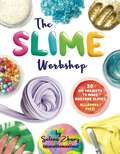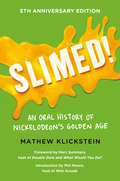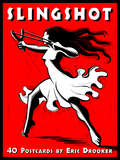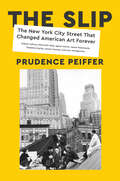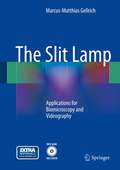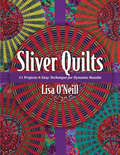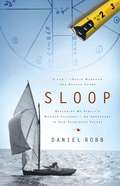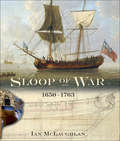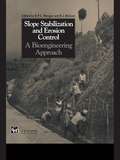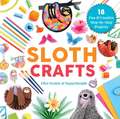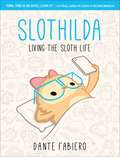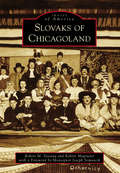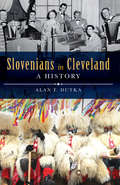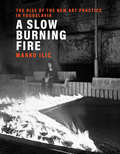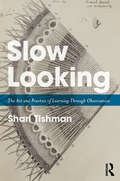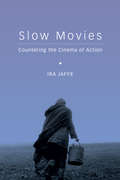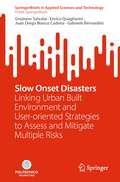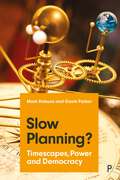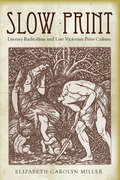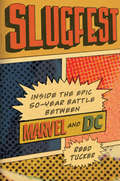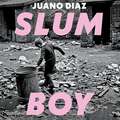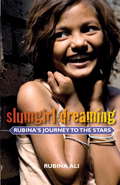- Table View
- List View
The Slime Workshop: 20 DIY Projects to Make Awesome Slimes—All Borax Free!
by Selina ZhangWhip up 20 borax-free slimes with different textures, cool colors, and special effects from slime enthusiast Selina Zhang (@anathemaslime)! Follow the step-by-step instructions to make slimes to squish, stretch, poke, and play with, including Glow-in-the-Dark Slime, Fluffy Slime, Fishbowl Slime, Unicorn Slime, and more. Along with fun variations, this irresistible full-color guide outlines the essential equipment and ingredients, the science of slime, tips on how to safely make and play with slime, and advice for preserving your creations and troubleshooting common problems.
Slimed!: An Oral History of Nickelodeon's Golden Age
by Mathew KlicksteinSLIMED! An Oral History of Nickelodeon's Golden Age tells the surprisingly complex, wonderfully nostalgic, and impressively compelling story of how Nickelodeon -- the First Kids' Network -- began as a DIY startup in the late 70s, and forged ahead through the early eighties with a tiny band of young artists and filmmakers who would go on to change everything about cable television, television in general, animation, and children's entertainment, proving just what can be done if the indie spirit is kept alive in the corporate world. Get the real back story about all of your favorite Golden Age Nick shows: Everything from such classics as You Can't Do That On Television, Out of Control and Double Dare to early 90s faves like The Adventures of Pete & Pete, the original three Nicktoons, Clarissa Explains It All and more ... All from those who made it happen!
Slingshot: 32 Postcards By Eric Drooker (Pm Press Ser.)
by Eric DrookerDisguised as a book of innocent postcards, Slingshot is a dangerous collection of Eric Drooker’s most notorious posters. Plastered on brick walls from New York to Berlin, tattooed on bodies from Kansas to Mexico City, Drooker’s graphics continue to infiltrate and inflame the body politic. Drooker is the author of two graphic novels and a collaborator with Beat poet Allen Ginsberg. His provocative art has appeared on countless posters and book covers, and his hard-edged graphics are a familiar sight on street corners throughout the world.
The Slip: The New York City Street That Changed American Art Forever
by Prudence PeifferLonglisted for the National Book Award · Shortlisted for the Apollo Book of the Year Award · A New York Times Notable Book of the YearThe never-before-told story of an obscure little street at the lower tip of Manhattan and the remarkable artists who got their start there. For just over a decade, from 1956 to 1967, a collection of dilapidated former sail-making warehouses clustered at the lower tip of Manhattan became the quiet epicenter of the art world. Coenties Slip, a dead-end street near the water, was home to a circle of wildly talented and varied artists that included Robert Indiana, Ellsworth Kelly, Agnes Martin, James Rosenquist, Delphine Seyrig, Lenore Tawney, and Jack Youngerman. As friends and inspirations to one another, they created a unique community for unbridled creative expression and experimentation, and the works they made at the Slip would go on to change the course of American art.Now, for the first time, Prudence Peiffer pays homage to these artists and the unsung impact their work had on the direction of late twentieth-century art and film. This remarkable biography, as transformative as the artists it illuminates, questions the very concept of a “group” or “movement,” as it spotlights the Slip’s eclectic mix of gender and sexual orientation, abstraction and Pop, experimental film, painting, and sculpture, assemblage and textile works. Brought together not by the tenets of composition or technique, nor by philosophy or politics, the artists cultivated a scene at the Slip defined by a singular spirit of community and place. They drew lasting inspiration from one another, but perhaps even more from where they called home, and the need to preserve the solitude its geography fostered. Despite Coenties Slip’s obscurity, the entire history of Manhattan was inscribed into its cobblestones—one of the first streets and central markets of the new colony, built by enslaved people, with revolutionary meetings at the tavern just down Pearl Street; named by Herman Melville in Moby Dick and site of the boom and bust of the city’s maritime industry; and, in the artists’s own time, a development battleground for Jane Jacobs and Robert Moses. The Slip’s history is entwined with that of the artists and their art—eclectic and varied work that was made from the wreckage of the city’s many former lives.An ambitious and singular account of a time, a place, and a group of extraordinary people, The Slip investigates the importance of community, and makes an argument for how we are shaped by it, and how it in turns shapes our work.
The Slit Lamp
by Marcus-Matthias GellrichIn this book the author describes in detail the history, construction, and examination potential of the slit lamp. In particular, however, he presents a new approach - videography - that allows the ophthalmologist to document all eye diseases with the slit lamp and a video camera in a practicable, rapid, and affordable manner. The necessary methods, techniques, and equipment, including converging, diverging, and contact lenses, are clearly explained in the text and four didactic videos. The 20 most important videographic settings are described, and "recipes" for their use are presented, along with diagnostic tips. The accompanying collection of clinical images represents the world's first ever general atlas of ophthalmology from the perspective of the slit lamp. It is the author's hope that this introduction to ophthalmological videography, with its many images never previously produced with a slit lamp, will stimulate others to exploit the approach's potential.
Sliver Quilts: 11 Projects Easy Technique for Dynamic Results
by Lisa O'NeillFeeling a little adventurous? Learn how to incorporate bright, decadent fabrics into your quilts without overwhelming your design.Add fresh, striking dimension and texture to traditional or contemporary quilts with Lisa O’Neill’s original “sliver piecing” technique. It’s easier than it looks, so you can make your classic or modern quilt blocks really snap with colorful fabric splinters! Lisa shows you how a folded piece of narrow fabric—the sliver—is inserted into a tuck in the background fabric. Then the raw edges of the sliver are encased in the tuck, while the folded edge of the sliver is revealed on the fabric surface. You’ll learn how to get perfect points or super slim strips without fusing or paper-piecing.“Sounds complicated, but we are assured by the author that it is easy and has many applications both with traditional blocks and in creating your own innovative pieces. This is an interesting idea with lots of potential, especially for the quilter who enjoys a little freedom of expression.” —Fabrications Quilting for You Magazine
Sloop: Restoring My Family's Wooden Sailboat--An Adventure in Old-Fashioned Values
by Daniel RobbNow in paperback, Daniel Robb’s Sloop proves he “is a craftsman… with words as well as with a hammer, as he constructs a charming tale that both details the technical nature of boatbuilding and captures the essence of the past, present, and future of a New England maritime community” (Publishers Weekly). • Interest in the environment and ecology: Daniel robb decided to restore his family’s well-worn wooden sailboat in appreciation for its craftsmanship and out of respect for the environment for which it was intended. Sloop’s tribute to the simple life and one’s environment will resonate with sailing enthusiasts and anyone who appreciates fine craftsmanship. • Timeless values: robb voices an ethic in which things are valued and appreciated, especially well-designed objects that still have years of useful life in them. While die-hard sailors or woodworking fanatics will love this book, robb’s skill as a writer also makes this a fascinating read for anyone. His humorous account of his on-the-job learning experience and of the eccentric characters who share his values and helped him will delight readers. “Robb writes of his painstaking restoration of a rotted 12½- foot herreshoff that had floated on memory and emotion, and finally again on water.…a gem.” —David Mehegan, The Boston Globe “Whether you’re an old-time boat builder, a wooden boat enthusiast, or simply someone who appreciates words woven together masterfully, you’ll enjoy Sloop.” —Kathleen Szmit, Barnstable Patriot Author of Crossing the Water, Daniel Robb has been an editor of academic journals, a teacher, a political consultant on a congressional campaign, and a proprietor of a literary services business. He has also worked at sea on schooners, taught sailing, and raced in national competitions. Robb lives in Pelham, Massachusetts.
The Sloop of War, 1650–1763: 1650-1763
by Ian McLaughlan&“A delight . . . fulfills a long-felt need to do justice to the smaller ships of war that did such sterling service for the sailing Royal Navy.&”—Ships in Scale This is the first study in depth of the Royal Navy&’s vital, but largely ignored small craft. In the age of sail, they were built in huge numbers and in far greater variety than the more regulated major warships, so they present a particular challenge to any historian attempting a coherent design history. However, for the first time this book charts the development of the ancillary types, variously described in the 17th century as sloops, ketches, brigantines, advice boats and even yachts, as they coalesce into the single 18th-century category of Sloop of War. In this era, they were generally two-masted, although they set a bewildering variety of sail plans from them. The author traces their origins to open boats, like those carried by Basque whalers, shows how developments in Europe influenced English craft, and homes in on the relationship between rigs, hull-form and the duties they were designed to undertake. Visual documentation is scanty, but this book draws together a unique collection of rare and unseen images, coupled with the author&’s own reconstructions in line drawings and watercolor sketches to provide the most convincing depictions of the appearance of these vessels. By tackling some of the most obscure questions about the early history of small-boat rigs, the book adds a dimension that will be of interest to historians of coastal sail and practical yachtsmen, as well as warship enthusiasts. &“Fascinating . . . It combines a truly scholarly delivery with a lovely presentation. History brought to life.&”—tomcunliffe.com
Slope Stabilization and Erosion Control: A Bioengineering Approach
by Roy P.C. Morgan R.J. RicksonThis book is an up-to-date review of research and practice on the use of vegetation for slope stabilization and control of surface erosion caused by water and wind. From a basic understanding of the principles and practices of vegetation growth and establishment, it describes how vegetation can be treated as an engineering material and used to solve erosion and slope stability problems.
Sloth Crafts: 18 Fun & Creative Step-by-Step Projects (Creature Crafts)
by Ellen DeakinThese crafts will make you appreciate the slower side of things! Try out these adorable crafts based on the animal that everyone’s talking about! Sloths are fuzzy, endearing, and oh-so-sweet! No one can resist their adorable faces—especially when they’re the inspiration for a dozen crafts that will have your sloth-loving friends oohing and aahing. With Sloth Crafts you’ll learn how to create sloth: PlushiesNecklacesOrnamentsBagsBroochesCakesScarvesMasksAnd more! Both novice and expert crafters will enjoy this wide variety of projects. Each craft comes with a list of all the items and templates that you will need to create your sloth-fueled fun. There’s no shortage of ways in which you'll be able to envision these fantastic sloth crafts―the perfect activities for any creative sloth fan. They're great for yourself or to give as gifts, but you’ll probably want to make them for both. Slow down, hang out, and get crafting with Sloth Crafts!
Slothilda: Living the Sloth Life
by Dante FabieroSlothilda is your spirit animal! Enjoy this completely relatable comic series about an adorable little sloth who's driven by her desire for self-improvement. Unfortunately, achieving her goals isn't always so easy. After all, she is a sloth, and being innately lazy often poses some interesting challenges to her personal growth. She constantly struggles to overcome procrastination, her love for junk food, and her addiction to modern day technology. Despite her lazy natural instincts, Slothilda remains ambitious and optimistic. She explores an inner conflict we can all relate to—the desire to succeed and grow, while paradoxically dealing with the ever present temptation to sloth.
Slovaks of Chicagoland (Images of America)
by Robert M. Fasiang Robert Magruder Monsignor Joseph SemancikThe story of Slovak Americans in Chicagoland is a tale of the American dream. In a few short years, emigrants from Slovakia with little to their names came to the United States and succeeded beyond their highest hopes. This fascinating story of "rags to riches" has been documented in historical photographs in Images of America: Slovaks of Chicagoland. Many Slovaks came to America with few assets, no more than a sixth-grade education, and no knowledge of the English language. They went to school and became naturalized citizens. Many took menial jobs in stockyards, steel mills, and oil refineries. They saved their money and opened grocery stores, banks, construction firms, and other businesses. Slovaks built beautiful churches, quality schools, and recreational facilities. They raised their families to be proud Americans and incorporated traditions from Slovakia into their daily lives, including the important role of religion.
Slovenians in Cleveland: A History (American Heritage)
by Alan F. DutkaThe Newburgh, St. Clair and Collinwood neighborhoods formed the core of Greater Cleveland's enormous Slovenian population, still the largest in America. The city's Slovenian heritage is replete with gripping tales of World War II prison camp escapes and bizarre bank robbers who threatened the St. Clair Savings institution. The catastrophic East Ohio Gas explosion and tragic Collinwood school fire are etched into local consciousness. The rise of neighborhood residents to professional sports stardom and national political prominence contribute to a proud legacy. And the century-old "Cleveland style" Slovenian polka remains an important cultural expression. Author Alan Dutka offers the first comprehensive history of the struggles and triumphs of Cleveland's Slovenians.
A Slow Burning Fire: The Rise of the New Art Practice in Yugoslavia
by Marko IlicYugoslavia's diverse and interconnected art scenes from the 1960s to the 1980s, linked to the country's experience with socialist self-management.In Yugoslavia from the late 1960s to the late 1980s, state-supported Student Cultural Centers became incubators for new art. This era's conceptual and performance art--known as Yugoslavia's New Art Practice--emerged from a network of diverse and densely interconnected art scenes that nurtured the early work of Marina Abramović, Sanja Iveković, Neue Slowenische Kunst (NSK), and others. In this book, Marko Ilić offers the first comprehensive examination of the New Art Practice, linking it to Yugoslavia's experience with socialist self-management and the political upheavals of the 1980s.
Slow Fashion: Aesthetics Meets Ethics
by Safia MinneySlow Fashion offers creatives, entrepreneurs, and ethical consumers alike a glimpse into the innovative world of the eco-concept store movement, sustainable design, and business that puts people, livelihoods, and sustainability central to everything they do. <p><p> Safia Minney argues that the future of brick and mortar retail is in the best in fair trade, sustainability, and organic products, together with vintage and second hand goods and local produce. Restorative economics, the well-being of our planet, and our bodies and minds can be inspired by this growing sector, one that is shaping big business.This book curates pioneering people and projects that will inspire you to be part of the change. International names include Livia Firth, Zandra Rhodes, and Lily Cole. American change-makers include Andrew Morgan, filmmaker (The True Cost, a ground-breaking documentary that asks us each to consider who pays the price for our clothing), and Dana Geffner (Fair World Project). <p> With full color photography and elegant design, Slow Fashion profiles the people bringing the alternatives to the mainstream: designers, labels, and eco-concept stores across the world; fair trade producers; campaigns that are re-designing the fashion economy; and the fibers and fabrics which are making a difference.
Slow Knitting: A Journey from Sheep to Skein to Stitch
by Hannah Thiessen“Thiessen has done her research, and talked to people who truly have insight into the process of making both yarn and clothing.” —Modern Daily KnittingLike the “slow food” movement, Slow Knitting encourages knitters to step back, pare down, and celebrate the craftsmanship of their work. In five chapters centered around the tenets of slow knitting—sourcing carefully, making thoughtfully, thinking environmentally, experimenting fearlessly, and exploring openly—Hannah Thiessen challenges knitters of all skill levels to view their practice in a new way. Each chapter contains explorations of fiber types; profiles of well-known yarn types, makers, and yarn suppliers; and garment patterns inspired by the featured fibers. With contributions from knitting superstars Norah Gaughan, Bristol Ivy, and many others, Slow Knitting proposes an approach to knitting that is both minimalist and all-encompassing, and emphasizes what makes knitting a meditation, a passion, and a unique necessity.“Promotes the concept of ‘slow knitting’ which discards the pressure to produce prolifically and instead, revolves around the idea that thoughtfully produced yarn will result in better projects for you-the crafter.” —MarthaStewart.com
Slow Looking: The Art and Practice of Learning Through Observation
by Shari TishmanSlow Looking provides a robust argument for the importance of slow looking in learning environments both general and specialized, formal and informal, and its connection to major concepts in teaching, learning, and knowledge. A museum-originated practice increasingly seen as holding wide educational benefits, slow looking contends that patient, immersive attention to content can produce active cognitive opportunities for meaning-making and critical thinking that may not be possible though high-speed means of information delivery. Addressing the multi-disciplinary applications of this purposeful behavioral practice, this book draws examples from the visual arts, literature, science, and everyday life, using original, real-world scenarios to illustrate the complexities and rewards of slow looking.
Slow Movies: Countering the Cinema of Action
by Ira Jaffe"In all film there is the desire to capture the motion of life, to refuse immobility," Agnes Varda has noted. But to capture the reality of human experience, cinema must fasten on stillness and inaction as much as motion. Slow Movies investigates movies by acclaimed international directors who in the past three decades have challenged mainstream cinema's reliance on motion and action. More than other realist art cinema, slow movies by Lisandro Alonso, Nuri Bilge Ceylan, Pedro Costa, Jia Zhang-ke, Abbas Kiarostami, Cristian Mungiu, Alexander Sokurov, Bela Tarr, Gus Van Sant and others radically adhere to space-times in which emotion is repressed along with motion; editing and dialogue yield to stasis and contemplation; action surrenders to emptiness if not death.
Slow Movies
by Ira Jaffe"In all film there is the desire to capture the motion of life, to refuse immobility," Agnes Varda has noted. But to capture the reality of human experience, cinema must fasten on stillness and inaction as much as motion. Slow Movies investigates movies by acclaimed international directors who in the past three decades have challenged mainstream cinema's reliance on motion and action. More than other realist art cinema, slow movies by Lisandro Alonso, Nuri Bilge Ceylan, Pedro Costa, Jia Zhang-ke, Abbas Kiarostami, Cristian Mungiu, Alexander Sokurov, Bela Tarr, Gus Van Sant and others radically adhere to space-times in which emotion is repressed along with motion; editing and dialogue yield to stasis and contemplation; action surrenders to emptiness if not death.
Slow Onset Disasters: Linking Urban Built Environment and User-oriented Strategies to Assess and Mitigate Multiple Risks (SpringerBriefs in Applied Sciences and Technology)
by Graziano Salvalai Enrico Quagliarini Juan Diego Blanco Cadena Gabriele BernardiniThe book provides an overview of the Slow Onset Disasters (SLOD) in the urban built environment discussing potential strategies to assess and mitigate multiple climate change related risks. Climate change evidence has been reported in the last decades, suggesting that the anthropogenic activities are accelerating these changes towards a warmer and more polluted environment. In this context, SLODs have been linked to climate change related disasters and have been stated to have a higher impact risk within dense built environment (BE). Therefore, the book presents a description of the most relevant SLODs, their significance, and confluence, the way in which scientists and entities are monitoring their progression at different scales, a structured risk assessment strategy and the deconstruction of the BE characteristics that make it more prone to SLODs risk. In addition, it highlights the necessity of adapting the traditional risk assessment methods, to account for different vulnerability types, including the morphology and materiality of the BE, and the BE users’ characteristics. In fact, individual features influence users’ responses and tolerance to environmental stressors, because of age, health, gender, habits, and behaviour, thus impacting the users’ vulnerability. Exposure can then amplify these issues, since it defines the number of users that can be effectively affected by the SLOD. Starting from this perspective, the book first traces literature-based correlations between individual features, use behaviour, and individual response to the SLOD-altered open spaces. Then, a novel methodology, to quantify the variations of users’ vulnerability and exposure, is offered, to support designers in quickly defining input scenarios for risk assessment and mitigation. Lastly, it demonstrates, through a case study, the SLOD risk assessment framework proposed and the evaluation of the efficacy of risk mitigation strategies.
Slow Planning?: Timescapes, Power and Democracy
by Mark Dobson Gavin ParkerA deep exploration on how questions of time and its organisation affect planning practice, this book questions ‘project speed’: where time to think, deliberate and plan has been squeezed. The authors demonstrate the many benefits of slow planning for the key participants, multiple interests and planning system overall.
Slow Print: Literary Radicalism and Late Victorian Print Culture
by Elizabeth Carolyn MillerThis book explores the literary culture of Britain's radical press from 1880 to 1910, a time that saw a flourishing of radical political activity as well as the emergence of a mass print industry. While Enlightenment radicals and their heirs had seen free print as an agent of revolutionary transformation, socialist, anarchist and other radicals of this later period suspected that a mass public could not exist outside the capitalist system. In response, they purposely reduced the scale of print by appealing to a small, counter-cultural audience. "Slow print," like "slow food" today, actively resisted industrial production and the commercialization of new domains of life. Drawing on under-studied periodicals and archives, this book uncovers a largely forgotten literary-political context. It looks at the extensive debate within the radical press over how to situate radical values within an evolving media ecology, debates that engaged some of the most famous writers of the era (William Morris and George Bernard Shaw), a host of lesser-known figures (theosophical socialist and birth control reformer Annie Besant, gay rights pioneer Edward Carpenter, and proto-modernist editor Alfred Orage), and countless anonymous others.
Slugfest: Inside the Epic, 50-year Battle between Marvel and DC
by Reed TuckerThe first in-depth, behind the scenes book treatment of the rivalry between the two comic book giants.THEY ARE THE TWO TITANS OF THE COMIC BOOK INDUSTRY--the Coke and Pepsi of superheroes--and for more than 50 years, Marvel and DC have been locked in an epic battle for spandex supremacy. At stake is not just sales, but cultural relevancy and the hearts of millions of fans.To many partisans, Marvel is now on top. But for much of the early 20th century, it was DC that was the undisputed leader, having launched the American superhero genre with the 1938 publication of Joe Shuster and Jerry Siegel's Superman strip. DC's titles sold millions of copies every year, and its iconic characters were familiar to nearly everyone in America. Superman, Batman, Wonder Woman--DC had them all.And then in 1961, an upstart company came out of nowhere to smack mighty DC in the chops. With the publication of Fantastic Four #1, Marvel changed the way superheroes stories were done. Writer-editor Stan Lee, artists Jack Kirby, and the talented Marvel bullpen subsequently unleashed a string of dazzling new creations, including the Avengers, Hulk, Spider-Man, the X-Men, and Iron Man.Marvel's rise forever split fandom into two opposing tribes. Suddenly the most telling question you could ask a superhero lover became "Marvel or DC?"Slugfest, the first book to chronicle the history of this epic rivalry into a single, in-depth narrative, is the story of the greatest corporate rivalry never told. Complete with interviews with the major names in the industry, Slugfest reveals the arsenal of schemes the two companies have employed in their attempts to outmaneuver the competition, whether it be stealing ideas, poaching employees, planting spies, or launching price wars. The feud has never completely disappeared, and it simmers on a low boil to this day. With DC and Marvel characters becoming global icons worth billions, if anything, the stakes are higher now than ever before.
Slum Boy: A Portrait
by Juano DiazOne of the most moving accounts of non fiction ever written according to the Guardian 'This is a heart-breaking story, beautifully told. I hope it finds a million readers' - Andrew O'Hagan'What a brave and powerful story. If you like Shuggie Bain and Damian Barr then Slumboy is for you' - Lemn Sissay'Compulsively readable, it's Dickensian in its rich cast of Glaswegian characters' - Patrick GaleJohn MacDonald must find his mother. Born into the slums of Glasgow in the late '70s, a 4-year-old John's life is filled with the debris of alcoholism and poverty. Soon after witnessing a drowning, his mother's addictions take over their lives, leaving him starving in their flat, awaiting her return.A concerned neighbor reports her, and he is forcibly taken away from his mother and placed into the care system. There, he dreams of being reunited with her. His mind is consumed with images and memories he can't process or understand, which his eventual adoptive parents silence out of fear as he grows into a young man within a strict Catholic and Romany Gypsy community.This memoir is about how John found his way to his true identity, Juano Diaz, and how, against all odds, his unstoppable love for his mother sets him free.
Slumgirl Dreaming: Rubina's Journey to the Stars
by Rubina AliMy name is Rubina Ali. I don't know when my birthday is, and nor does my father, but I do know that I am nine years old. Young Rubina is a one-in-a-million star. Plucked from among five hundred slumkids who auditioned for Danny Boyle's multi-Oscar-winning filmSlumdog Millionaire,she saw her fairy-tale dream of stardom come true. Now that she has stepped into the limelight, what will life hold for a young girl from the Mumbai slums? Rubina tells her own incredible story, bringing to life a world of wastelands and rat-infested shanty dwellings, where she played marbles with her friends beside the sewers of Garib Nagar. She introduces her beloved father, a hardworking rickshaw puller, and her siblings. And then Rubina tells of the kindness of Danny Boyle and of the time she spent on the film sets--including the hilarious incident when her costar came to be covered in chocolate from head to toe. After her brief encounter with red-carpet glamour, how will Rubina come to terms with the conditions in which she, her family, and her friends continue to live since Hollywood came knocking? This is her compelling story.
